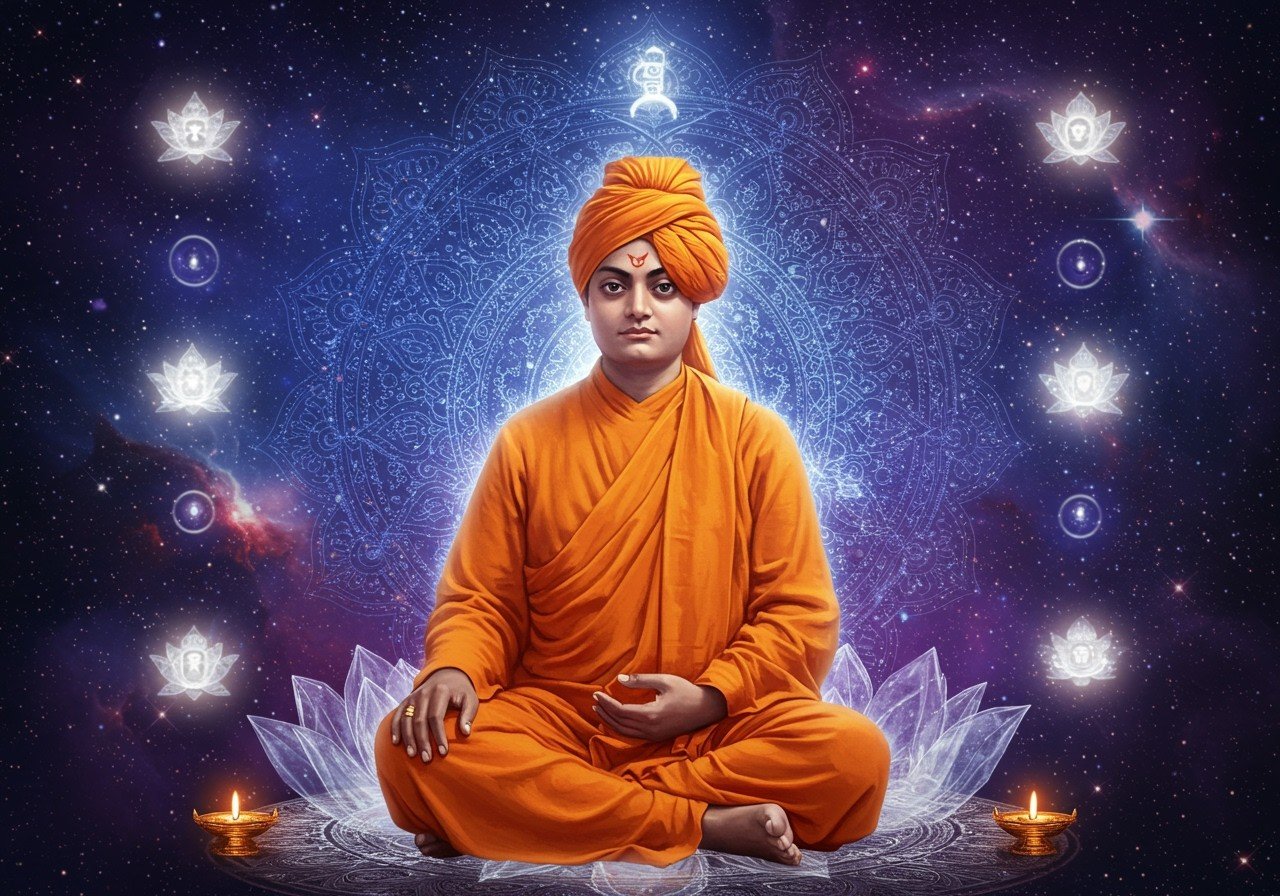
Swami Vivekananda, a revered spiritual leader and philosopher, shared India’s rich spiritual heritage with the world. His profound wisdom and practical approach to spirituality, particularly his teachings on meditation and yoga, continue to guide seekers today. This blog post delves into his meditation techniques and spiritual practices, offering a practical guide for incorporating these teachings into your daily life. We’ll explore the significance of meditation in Vivekananda’s philosophy and its relevance in our modern, fast-paced world.
Understanding Swami Vivekananda’s Approach to Meditation
Swami Vivekananda considered meditation a crucial pathway for spiritual growth and mental discipline. He believed it to be a powerful tool for self-discovery, leading to inner peace and a deeper understanding of oneself. For him, meditation was more than just a practice; it was a way of life, a way of being. Vivekananda’s teachings emphasize concentration and mindfulness as the keys to unlocking deeper spiritual awareness.
Key aspects of Vivekananda’s Meditation Approach:
- Meditation is vital for spiritual unfolding and self-realization.
- He stressed the importance of finding inner peace and self-knowledge through regular meditation.
- Concentration and mindfulness are central to his teachings.
- He outlined stages of meditation to progressively deepen awareness and understanding.
Vivekananda taught ‘Raja Yoga,’ the path of meditation and mastering the mind. He emphasized the importance of personal experience and dedicated self-effort in one’s meditation practice. He believed that true understanding comes from within, through direct experience.
Embracing the Wisdom: How to Meditate Like Swami Vivekananda
1. Preparing Body and Mind: Posture and Focus
- Comfortable Posture: Find a comfortable seated position where you can remain still for an extended period. Make sure your spine is not bearing the full weight of your body, allowing the energy to flow freely. You can sit on a cushion or a comfortable mat.
- Straight Spine: Maintain an erect posture, keeping your body, neck, and head aligned. A straight spine is essential for the free flow of nerve currents, which are vital for deep meditation.
- Focus Your Gaze: Gently direct your attention to the point between your eyebrows, often referred to as the ‘third eye’ or ‘ajna chakra’. This helps to internalize your focus and concentration.
2. Mental Preparation: Cultivating Inner Peace
- Positive Thoughts: Begin your meditation by radiating positive thoughts and well wishes towards all beings. Mentally repeat a prayer or affirmation like, “Let all beings be happy; let all beings be peaceful; let all beings be blissful,” extending these sentiments in all directions – east, south, north, and west.
- Turning Inward: Meditation is a process of turning your attention inwards, away from the distractions of the external world. It involves gently quieting the mental chatter and stilling the thought waves, allowing the mind to become calm and receptive.
3. Meditation Practice: The Journey Within
- Self-Appraisal: Gently observe your thoughts and emotions without judgment. Become aware of the patterns of your mind, recognizing the thoughts that arise and pass away.
- Affirmation: Connect with your true nature – existence, knowledge, and bliss (sat-chit-ananda). Recognize the unity of subject and object, the interconnectedness of all things.
- Concentration: Focus your mind on a single object, image, or mantra. Visualize your concentration as steady and unbroken, like a continuous stream of oil. If desires or distractions arise, simply observe them calmly, without getting carried away. Let them pass like clouds in the sky.
- Stillness: As you continue to practice, your mind will naturally become calmer and more still. The thought waves will gradually subside, allowing you to experience a deeper sense of peace and clarity.
4. Achieving Oneness: The Ultimate Goal
- Renunciation: Let go of attachments, fears, and anger. Surrender your ego to the divine and purify your heart. This process of letting go creates space for inner peace and spiritual growth.
- Realization: Through consistent and dedicated practice, you can experience oneness with the Divine. This realization can manifest through knowledge, love, or renunciation, depending on your individual path.
Key Concepts and Techniques: Exploring Deeper Aspects of Meditation
- Raja Yoga and Vedanta: Swami Vivekananda’s meditation teachings draw from both Raja Yoga (a practical and mystical approach) and Vedanta (a philosophical and transcendental approach). Both paths aim to achieve enlightenment through the realization of the Supreme.
- Concentration: Vivekananda considered concentration to be the essence of all knowledge and education. He advocated for developing the power of concentration and detachment, enabling us to focus our minds and gather knowledge effectively. You can explore the concept of mindfulness further here.
- Thought Control: Initially, meditation might involve a form of “negative meditation,” where you consciously try to quiet the mind by letting go of thoughts. This helps you analyze your thought patterns and gain control over your mind through willpower. For additional insights on meditation challenges, read more.
Benefits of Meditation: Experiencing the Transformative Power
- Increased Mental Strength: Regular meditation strengthens the mind, enhances focus, and improves emotional regulation. It also fosters a deeper sense of connection with others and the world around you.
- Scientific Discovery: Meditation can facilitate scientific breakthroughs and insights. By deeply immersing oneself in a subject and letting go of all preconceptions, new understanding can emerge spontaneously, like a flash of inspiration.
- Spiritual Growth: Meditation is a direct path to spiritual awakening, allowing the soul to connect with its true nature, free from the limitations of the material world. Dive into the different types of breathing exercises for meditation to deepen your practice.
- Rest and Peace: Meditation offers profound rest and rejuvenation, even more restorative than deep sleep. It calms the nervous system, reduces stress, and promotes a sense of inner peace and well-being.
Poojn.in: Supporting Your Spiritual Journey
At poojn.in, we offer a curated selection of authentic puja items and spiritual resources to support your meditation practice and deepen your connection with Swami Vivekananda’s teachings. Our collection includes:
- Incense Holders: Pure brass incense holders to create a serene and sacred atmosphere for meditation.
- Meditation Asanas: Traditional meditation mats (asanas) crafted from natural materials for comfortable and grounded practice.
- Spiritual Books: A selection of books on Swami Vivekananda’s philosophy, meditation techniques, and spiritual practices.
- Ritual Bells: High-quality brass and copper bells for traditional rituals and ceremonies.
- Meditation Shawls and Clothing: Pure cotton meditation shawls and comfortable clothing to enhance your practice.
Experience the Convenience of Shopping with Poojn.in:
- Free Shipping: Enjoy free shipping across India on eligible orders.
- Secure Payments: Safe and secure online payment options for a hassle-free experience.
- Expert Guidance: Connect with our knowledgeable team via WhatsApp (9476142738) for personalized guidance on product selection.
- Phone Support: Reach us at 03369029784 for any assistance or inquiries.
- Quality Assurance: We guarantee the authenticity and quality of all our ritual items.
Visit Poojn.in or contact us today to discover the perfect spiritual items for your meditation practice. Our dedicated team is here to help you select authentic products that align with traditional practices while meeting modern quality standards. Please note: All products are subject to availability. Check our website for current stock and prices.
Swami Vivekananda’s Enduring Legacy: A Timeless Path to Inner Peace
Swami Vivekananda’s meditation techniques offer a profound and timeless path to inner peace, self-discovery, and spiritual fulfillment. By embracing these practices, you can cultivate concentration, self-awareness, and a deeper connection with the divine. His teachings remind us of the enduring wisdom within our traditions and the transformative power of meditation in daily life. Whether you seek mental clarity, spiritual growth, or simply a moment of tranquility, incorporating these practices can enrich your journey. As you embark on this path, may you find the peace and wisdom that Swami Vivekananda envisioned for all.
Frequently Asked Questions about Swami Vivekananda’s Meditation and Spiritual Practices
How did Swami Vivekananda typically meditate? Swami Vivekananda emphasized concentration and control of the mind in his meditation practice. He often focused on a single thought, image, or the divine to achieve a state of deep absorption.
What were Swami Vivekananda’s views on meditation? He considered meditation an essential tool for self-realization and communion with the divine. He strongly encouraged regular practice for achieving mental clarity and inner peace.
Did Swami Vivekananda incorporate yoga into his practices? Yes, yoga was an integral part of Swami Vivekananda’s spiritual practices. He was a proponent of Raja Yoga, a path focused on meditation and mental discipline.
According to Swami Vivekananda, why is meditation important? He believed meditation was crucial for spiritual growth and purification of the mind. It helps cultivate concentration, self-awareness, and a deeper understanding of oneself and the universe.
What are some of Swami Vivekananda’s key meditation techniques? His techniques include focusing on a mantra (sacred sound or phrase), visualizing a deity or symbolic image, and practicing deep, conscious breathing to cultivate inner peace and concentration.
How can I begin practicing Swami Vivekananda’s meditation techniques? Start by dedicating a quiet time and space for daily practice. Begin with shorter sessions, focusing on your breath or a simple mantra. Gradually increase the duration as you become more comfortable with the practice.
How do Swami Vivekananda’s teachings connect with his spiritual practices? His teachings emphasize the integration of meditation, yoga, and selfless service. These practices aim to create harmony between body, mind, and spirit, leading to a more meaningful and fulfilling life. Explore the profound impact of spiritual teachings on daily living.


